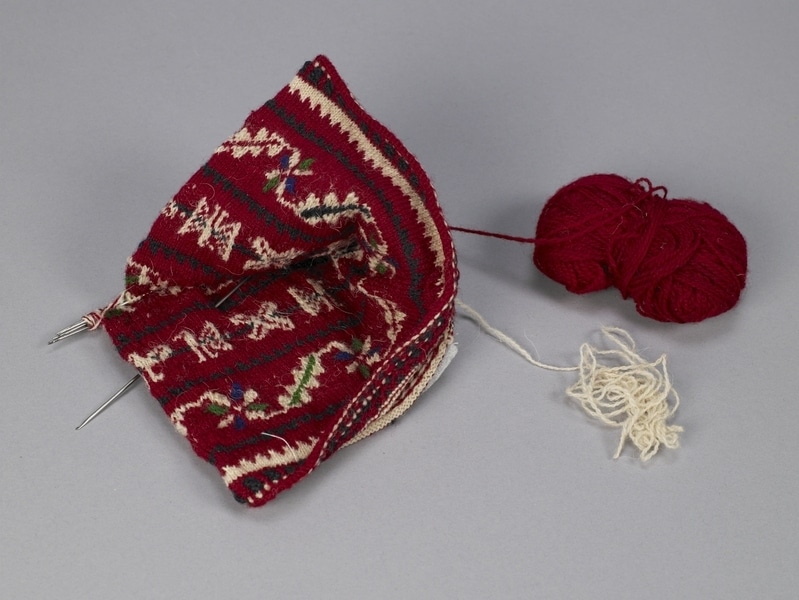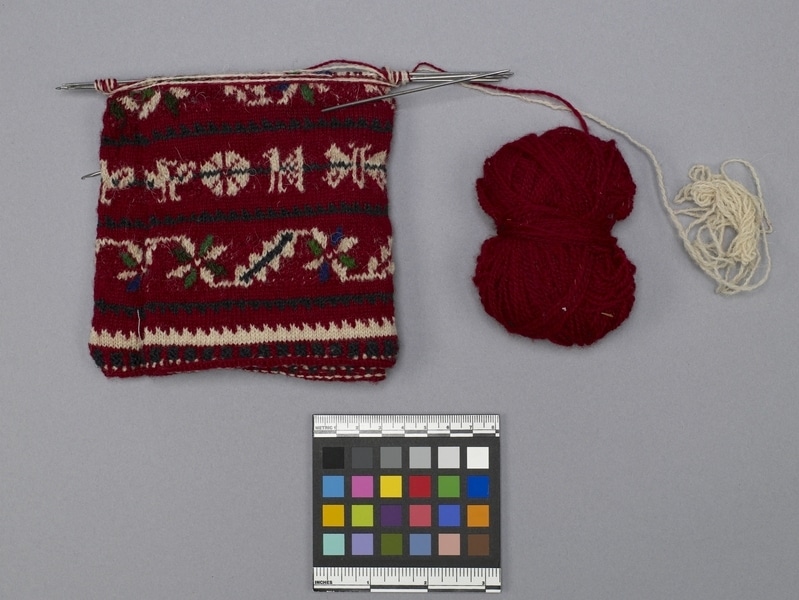Unfinished Hat Item Number: Sf944 from the MOA: University of British Columbia


Description
Partially finished cap on knitting needles, with two colours of yarn attached. The knitting is mounted on four needles and the circular fabric is folded in half. The needles, including the fifth for transferring stitches, are lined up parallel and bound together with the unused yarn. Rows of geometric patterns in white, blue, and green, divided by thin blue lines. Checker effect of blue, red and white along edge.
History Of Use
The colour, extent of patterning, shape and the manner in which chullus or caps are worn signal differences in age, sex and status of the wearer. Females wear chullus in early childhood, but only males wear them later in life. Traditionally, knitting is done only by men and boys, formerly for chullus, but recently also for vest fronts, coin purses, gloves, ties, vests and sweaters which are sold to tourists. This is the soltero or single man's style of cap. Married men sometimes wear it, especially for communal work parties, although everyone agrees it is the style for single men.
Cultural Context
knitting process
Narrative
Augustin was working on this hat during May, 1982. It would have been used by a family member or sold to visiting tourists. The needles are bought in Puno and the hooks are fashioned by the knitter who bends and flattens the ends. Knitting is done while sitting or walking. Red and white yarn is carried in 2 pockets and the strands pass around the neck downwards to the needles. Extra colours are carried along in local areas.
Specific Techniques
Plain knitting done circularly on five needles with extra colours carried on the inside for local colour areas.
Iconographic Meaning
The range of motifs refers to local geography and landmarks, ecology, fecundity as well as luck. The six part circle refers to the division of land into six sections on Taquile and the rotation of crops and fallow periods. The s or z shaped reverse curve can refer to the boat port or other objects that contain the idea of turning or returning such as a recurved potato hook. The cross or x-shape can refer to the warping cross in weaving, the crossroads or other intersections. The stepped diagonal lines refer to stairs on the steep island, but also to the connection with the afterworld in a particular myth. The motifs represent basic concepts or interrelationships and may have different particular references.
Item History
- Made by Agustin Quispe Mamani (Maker) in Taquile, Puno, Peru during April 1982
- Collected by Mary Frame during 1982
- Owned by Mary Frame before February 10, 1983
- Received from Mary Frame (Seller) and Museum of Anthropology Shop Volunteers (Funding source) on February 10, 1983
What
- Name
- Unfinished Hat
- Identification Number
- Sf944
- Type of Item
- hat
- Material
- wool fibre, metal, synthetic fibre and dye
- Manufacturing Technique
- knitted and hammered
- Overall
- height 14.0 cm, width 20.0 cm
Who
- Culture
- Quechua
- Creator
- Agustin Quispe Mamani (Maker)
- Field Collector
- Mary Frame
- Previous Owner
- Mary Frame
- Received from
- Mary Frame (Seller) and Museum of Anthropology Shop Volunteers (Funding source)
Where
- Holding Institution
- MOA: University of British Columbia
- Made in
- Taquile, Puno, Peru
When
- Creation Date
- during April 1982
- Collection Date
- during 1982
- Ownership Date
- before February 10, 1983
- Acquisition Date
- on February 10, 1983
Other
- Item Classes
- textiles
- Condition
- good
- Accession Number
- 0861/0031